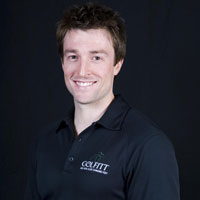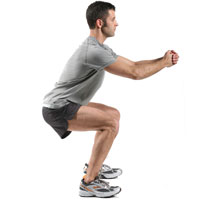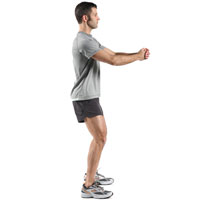Fitness: Squat For Power
- Details
- Category: Inside Golf
- Published: 2015-12-30
According to Golf Teaching Professional David Leadbetter, the golfer must build a firm base for the golf swing by building a solid posture at address to engage and stabilize the core muscles.

This enables the golfer to maintain good balance throughout the swing and encourages the golfer to swing the club on a repetitive track.
Image Caption : Dr. Ryan Emmons (Sport Chiropractor And Certified Golf Performance Therapist)
At first glance the squat may not look like a golf exercise, but it just might be the best exercise for your golf game. It will effectively develop a solid posture and thereby build a firm base for the golf swing.
The squat will also improve balance, flexibility, strength and stability -- all factors required to maximize power of the golf swing.
Posture
Proper squat technique requires optimal posture. This will reinforce good body positioning during exercise and golf and optimize balance of the golfer which creates a firm base in address stance.
Balance
The squat improves balance by increasing the capability of the muscle and joint proprioceptors (sensors in the muscle and around the joint to maintain proper position and alignment).
Balance in the athletic stance of the address position will minimize postural sway and allow for optimal swing mechanics and power development.

Flexibility
The squat forces the body to travel through a large range of motion and relies on many joints to bend to accomplish the movement.
In doing the squat, the gluteal muscles (buttocks), quadriceps muscles (front of the thigh), inner thigh muscles and the calf muscles (back of the lower leg) elongate and applies an effective stretch to these muscles whereby flexibility can be improved.
Strength
Strength is a precursor for power. The squat strengthens the entire body as every muscle in the body is forced to work.
Stability
Opposing muscles with optimal strength and flexibility are referred to as balanced. When muscles are balanced, the body is muscularly stable.
A stable body position will maximize power in the swing; muscles will be positioned in their optimal position thereby maximizing their capability.
A crucial body region requiring stability is the core. The core allows for greater efficiency of movement in the swing and facilitates force transfer from the feet to the hands and the club face.
Large compound exercises, such as the squat, can be significantly more effective at exercising stability of a healthy core than isolated core exercises. This is for numerous reasons:
The added resistance will increase the workload on the core muscles and train them with a greater intensity.
The squat is a dynamic exercise and trains the core in active movement thereby reinforcing the muscular stability and allowing a transfer effect into the golf swing.
The Challenge
The most difficult aspect of the squat is doing the technique properly. The squat is one of if not the most difficult exercise to perform correctly. This is because of the muscle weakness and inadequate flexibility existing in the majority of golfers. It is therefore most appropriate to consult an exercise specialist to assist with achieving good squat technique.
The Exercise
BODY POSITION
Face forward. Position your shoulder blades in a ‘set’ pulled back position and ensure a neutral arch in your lower back.
Your feet are approximately shoulder width or slightly wider with the hips knees and ankles slightly bent and relaxed.
The toes may be pointed out slightly or pointing forward; ensure that your knees follow the same direction through the movement (i.e. don't point toes out and have knees travel inwards).

PERFORMANCE
Sit back and down with your head looking straight ahead or very slightly upwards by simultaneously bending the hips and knees. Your upper body will naturally bend forward to keep you balanced; allow it to bend from the hips (not from the waist).
Keep the lower back slightly arched and do not allow it to round as you descend.
At the bottom of the squat, keep the muscles tight and engaged.
The ascent from the squat should be a smooth unfolding of the body by pushing through your heels and mid-feet. Keep looking forward or slightly up, and keep the back tight. Do not allow your knees move inward on the ascent.
TRAINING TIPS
Maintain a neutral spine position throughout the squat movement.
Keep the body weight distributed on the heel and mid-foot. Avoid excessively pushing through the balls of the feet and toes.
PROGRESSION
The exercise intensity can be increased by 1) holding a medicine ball, 2) resting a bar on your upper back, or 3) holding dumbbells at you side.
About the Author
Dr. Ryan Emmons is a Sport Chiropractor and certified Golf Performance Therapist. He is the developer of the GOLFITT Golf Conditioning Program and is the developer and instructor of the GOLFITT Golf Performance Trainer certification.
Dr. Emmons is based out of Calgary and can be contacted at This email address is being protected from spambots. You need JavaScript enabled to view it..



